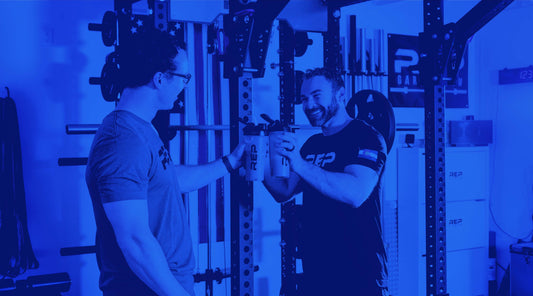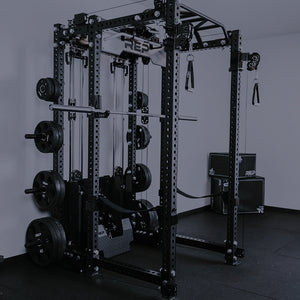
Sweat, stretch, and settle in
You just forced yourself to the gym, or maybe completed an epic outdoor workout, and now you're expected to cool down after exercising?! Some light cardio, a little self-myofascial release, and after workout stretches? The torture!
While there have been butt loads (that's the scientific term) of studies on the benefits of a proper warm up before you lift weights, the science on cooling down isn't quite as stacked. Does skipping it hurt you? Not really. Is it beneficial? Possibly — but the jury's still out and the studies have been mixed. Still, a few minutes of gentle movement and stretching won't kill you, and it might just help your body recover a little faster, especially after an intense workout. Here's what a cool down actually does and how to do it right.
The Benefits of a Cool Down
While most studies suggest that an active cool down won't reduce muscle soreness, speed up muscle damage recovery, or contribute to injury prevention in the same way a warmup will, there are still some potential benefits of this post-workout add on.
Heart and Lungs Help: May decrease recovery time for the cardiovascular and respiratory systems.
Circulation: Studies have shown that an active cool down supports circulation which helps to prevent pooling of blood in the lower extremities (which can cause dizziness) and remove lactate from the blood. However, the research is inconclusive if this also aids in removing lactate from muscles.
Slow Down: A cooldown, especially after a rigorous workout, can help to ease your blood pressure and bring your heart rate down into a resting state.
Improves Range of Motion: Tossing in some stretching at the end of a workout can improve your flexibility and joint mobility (when done consistently).
Post-Workout Mindfulness: By slowing things down, you'll have a moment to check in on your body, reflect on the work you just tackled, or just take a deep breath — all of which can contribute to your mental well-being.
An Amuse-Bouche of Cardio: Topping off your workout with a light jog or cycle is a great way to slow things down while checking "cardio" off your to-do list. Bonus: this low-intensity cardio won't interfere with your goals of building maximum strength or size.
Social Hour: If you just tackled a grueling workout with your gym buddy, use this time to connect over the shared experience, catch up on each others lives, and plan your next workout.

So, while the physiological perks of a cool down might be up for debate, it still offers a valuable window to reset your body and mind before diving back into the rest of your day.
What Happens If You Just... Leave the Gym?
You've figured out your routine, nailed how often you should work out, dialed in your protein intake, and finally mastered that one machine at the gym that always gives you trouble. Your workout is done. The exercise mat in the corner calls to you, "Come lay your sweaty body on me and stretch or something."
But you've got places to be, people to see, snacks to snack, and tv shows to catch up on. So, do you really need to cooldown after exercising? What happens if you just... leave the gym after your routine? Are you doomed? Will you suffer the consequences?!
Luckily, your body naturally begins to cool down once you stop exercising. If you head home and plop down on the couch, that's considered a passive cool down — your heart rate, breathing, and body temperature will gradually return to baseline as you rest.
That said, adding a short cooldown with low-intensity movement may offer some benefits, like promoting circulation and helping you shift into a post workout recovery mode. It's not essential, but if you have the time, it's a nice way to ease out of your workout.
How To Cool Down After a Workout
If you're wondering what to do after a workout, the National Academy of Sports Medicine has some guidance. NASM recommends 5 to 10 minutes of low-intensity cardiovascular exercise to help lower your heart rate, reduce blood pressure, and bring your body temperature back to baseline, followed by static stretching and/or self-myofascial release.
Low-Intensity Cardiovascular Exercise
Help ease your body into rest by wrapping up your workout with 5 to 10 minutes of cardio at a gradually decreasing intensity.

- Jog on a treadmill
- Ride an exercise bike
- Row with light strokes
- Use an elliptical machine at a low resistance
- March in place
- Dance like no one's watching
Self-Myofascial Techniques and Tools
Flexibility training is a smart addition to your cool-down — including both static stretches and/or self-myofascial release, which is a practice of applying pressure to help relax contracted muscles. These methods can improve your joints range of motion and may help manage muscle soreness.
- Foam roll tight or sore muscles. And for experienced rollers, consider the high density foam roller with textured peaks for a deep-tissue massage.
- Roll a massage ball between a hard surface and any area that needs attention.
- Use a percussion massage gun over muscles you targeted in your workout.
- Press a massage roller stick into and across sore or tight muscles.
Static Stretching
Unlike dynamic stretching which involves a controlled movement — like how soccer players swing their legs forward and back before a game — static stretches are done while the body is at rest. Hold each of these cool down stretches at the point of mild tension without bouncing.
Here are five static stretches to include in your stretching exercises workout as part of your cooldown:
Hamstring Stretch
How To Hamstring Stretch: Sit on the floor with both legs out straight in front of you. Pull the leg you're not stretching in so that the knee goes wide. For your remaining straight leg, flex your toes, lock out your knee, then curl forward at your hips while maintaining a flat back.
Quad Stretch
How To Quad Stretch: Stand tall with feet hip-width apart. Bend one knee and send your foot behind you, grabbing onto that foot behind you to keep the leg stretched. Make sure to keep the stretched leg's knee facing the ground. If it's difficult to maintain balance, you can also use one hand on a chair or doorway to keep you steady.
Prone Chest Stretch
How To Prone Chest Stretch: Move down to the floor like you're preparing to take a nap on your side. Extend one arm behind you with your palm facing the floor. With your other hand, push against the floor until you feel a good stretch in the pectoral muscle that's closest to the floor. Then, switch sides.
Supine Spinal Twist
How To Supine Spinal Twist: Lie flat on your back with your arms extended out, knees bent, and feet on the floor. Send your knees over to one side, maintaining contact on the ground with your shoulders as you do. Take one hand and pull down on your knees to assist with the stretch to target your lower back.
Child's Pose
How To Child's Pose: For hips and lower back pain try this classic yoga stretch. Kneel on a yoga mat and sit back on your heels. Fold forward and reach your arms forward, keeping your elbows straight, so that your palms rest on the ground over head.
For both static stretching and self-myofascial techniques, spend at least 30 seconds on each muscle you target. Why 30 seconds? This is the minimum amount of time needed to start increasing muscle length and flexibility. After 30 seconds, sensory receptors called Golgi tendon organs signal the muscle to relax — helping you get a more effective stretch and release.
Takeaway
To cool down or not to cool down — that is the question. While the science behind its benefits is limited, a cooldown can help you ease out of an intense workout by lowering your heart rate, allow you to catch your breath, and quite literally cool your body temperature down. Spend 5 to 10 minutes wrapping up your workout with light cardio, followed by either static stretching or self-myofascial release — targeting each area for at least 30 seconds. Cool down it if it brings you joy and makes you feel good — or skip it if you're on crunched for time.
FAQs
Why is a cooldown important after a workout?
Cooling down after your workout helps to ease your body back into rest by gradually lowering your heart rate, supporting circulation, reducing blood pooling in the extremities, and giving you a moment to focus on flexibility and mobility. While evidence is mixed on whether coodowns significantly reduce muscle soreness or prevent injury, they may still benefit cardiovascular and respiratory recovery and offer a structured way to ease out of your training session.
How to stretch lower back and hips?
If your lower back and hips feel tight and/or sore, try a supine spinal twist or child's pose stretch to release tension, improve mobility, and help your body relax after a workout. These stretches can target both areas at once, making them an efficient addition to your cooldown.
Rosie Borchert is NASM-CPT, former Nike Volleyball coach, and fitness writer whose work has appeared on BarBend and Tonal. If anyone would like to hire her to play beach volleyball, snowboard, binge watch TV, or go climbing, please get in touch.
This article was reviewed by Ashley Boyer, ACE-CPT, for accuracy.
similar to this

NEWSLETTER SIGNUP
Product launch information, promotions, blogs, and REP news.







